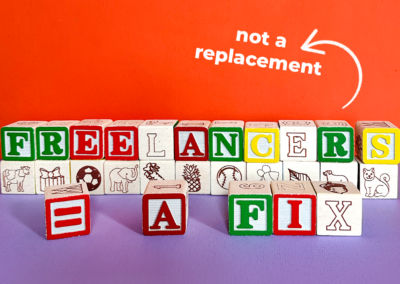A recent McKinsey study shows that 40% of employees are thinking of leaving their jobs. What they want isn’t more money or perks but greater appreciation and connection to their jobs.
As companies acknowledge and begin to address this reality about work culture, personality type and communication preference are often overlooked in DEIB strategies, but they are vital to creating work environments that work for everyone. In order to create cultures where employees feel valued and heard, leaders especially need to remember that 30-50% of the population are introverts.
Following are five strategies leaders can use to be more inclusive and mine the creativity and problem solving skills of their entire team.
1. Send agendas in advance so introverts can collect their thoughts
Introverts don’t have fewer ideas; they have fewer impulses to share them before they’re fully baked.
We’ve all sat through listless meetings and wished we could get that time back. But for introverts, there’s often an added frustration of wishing they had spoken up before someone else jumped in with a similar idea.
Sending agendas in advance of a meeting is a small shift that can have huge payoffs. It affects the number of people you hear from in meetings and the quality of ideas coming out of those meetings.
Not only does it give meetings more purpose and make better use of everyone’s time, it gives introverts time to collect their thoughts and come prepared to talk about their ideas.
One of the leaders I interviewed, Angie Herman Director, Retail Field Enablement at Charles Schwab, described it like this: “Being an introvert, and I’m sure you’ve heard this a zillion times, but if I’m in a meeting I often can’t come up with an idea on the spot. I need to soak up all the knowledge, think about it and then come back, with a plan.”
2. Encourage interaction but not interruption
Establish community guidelines and rules of engagement for meetings. I like 1, 2, 3, then me.
I first encountered this concept as a participant in a series of race workshops and have been sharing it with clients ever since.
It’s a simple and effective way to set expectations and make space for quieter voices. After one person speaks, let three more people speak before you chime in again. This simple rule gives people a way to monitor themselves and teammates and safely call attention to when someone is talking more than their share.
Instead of filling space with talking, it creates comfort around waiting. It builds in pauses and more opportunities for people to speak without having to fight to be heard.
3. Vary meeting facilitators
If you have weekly meetings, change up who’s leading the meeting. Switching up meeting facilitators cultivates leadership skills at all levels, shifts the dynamic of who normally does the talking, and provides variety in thought (and who doesn’t want variety at this point in the pandemic).
Different leaders draw out different voices and with more voices comes more diverse perspectives, more creative solutions and more investment in a successful outcome.
I worked with a client who was accustomed to taking a backseat role in new business pitches. When her firm was pitching a women’s institution she was selected to lead the pitch.
As an introvert, she brought a quieter, more thoughtful approach to investing that appealed to the committee and won the project. Her contributions might have been overshadowed if not for shifting the dynamics at the meeting.
4. Listen with all your senses
So often introverts are told they’re too quiet and they need to speak up more. This feedback puts the onus on introverts to change their personality instead of creating structures that are more inclusive.
Creating a space where introverts feel comfortable requires leaders and teams to not only ask more questions, but wait for the answers.
The way I teach this to clients is through a concept I developed called Listening with all Your Senses.
If you’re listening only to the words people are saying, you are leaving a lot of meaning on the table. Tapping into the five senses builds deeper listening skills so you can move beyond hearing to listening and understanding meaning.
Beyond the words people are saying, watch for hidden messages in facial expressions, gestures and tone.
Pay attention to what people are saying and what they’re not saying between the lines.
Ask yourself:
Does the tone feel hot and burning or chillingly cold?
Do the words taste sweet, spicy or bitter?
Is the conversation rich and meaty or salty and skeptical?
Pay attention to what feelings come up as you listen.
A client who works for the Federal Government described this practice as: “It pulls me into a state where I absorb what the person is saying, which naturally slows down the pace of a high pressure discussion.”
5. Eliminate the wild west dynamic in brainstorms
The problem with most meetings is that they favor employees who jump in first or speak the loudest.
While you might not think this is a problem, consider what you’re missing if you’re hearing from the same people over and over again: the creativity and problem solving skills of 50% of your team.
Building in thinking time to brainstorms can vastly increase the number of people you hear from in meetings. The simple act of giving people a minute or two to think and write down their ideas allows introverts (and anyone else who needs more processing time) to collect their thoughts. In addition, asking people to share in the chat and calling on people directly who you haven’t heard from can multiply your efforts in being inclusive, making people feel heard and helping teams bring the best ideas to the table.
Each of the strategies above can be implemented without requiring additional resources or special training. These small investments in your time can make a world of difference in increasing employee satisfaction, creating more inclusive team environments, and enhancing creativity and company decision-making by embracing the power of introverts on your team.
Madeline’s Socials: Instagram, LinkedIn, Website,
Editor’s Socials – Elisa Camahort Page: Instagram, Twitter, LinkedIn



